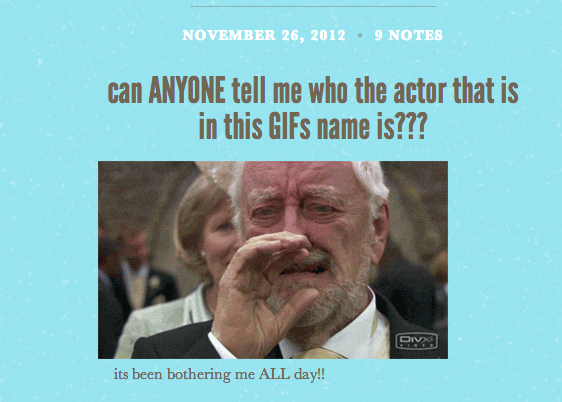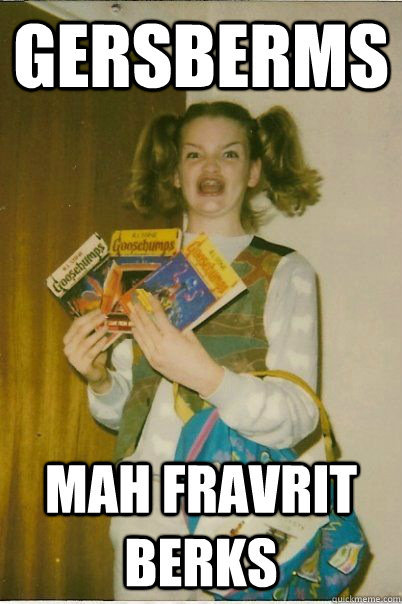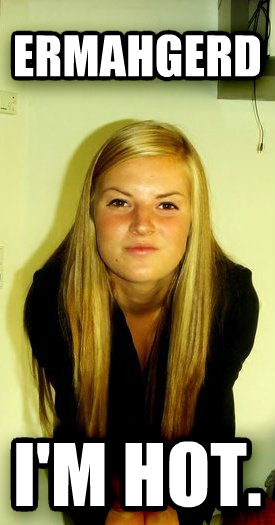
Image Credit: Deeras23
In my previous post, I outlined DeCordova’s arguments about the emergence of a discourse on acting in the early 20th century, and the contributions that discourse made to modern conceptions of celebrity, beginning in silent film. In this post, I’d like to translate those arguments into a discussion of 21st century media and attempt to outline a discourse on “gifing,” and what that can tell us about the intersections of gifs and celebrity in the 21st century public sphere.
I ended my post with the suggestion that the embedded “meme” or mimetic function of gifing was the essential element of gifing as a medium that allows for a conception of gif celebrity. Here, I’d like to explore the early stages of that celebrity in the predecessor to the gif: the “meme” itself.
Early this year, Business Insider published a puff piece of “What 6 Viral Internet Meme Stars Look Like in Real Life.” Most of this content was pulled from the popular internet archive Know Your Meme, which more fully documents who ascertained the true identities of these “meme stars,” and how. (A large portion of the investigative activity took place on the message boards of the popular social news and entertainment site Reddit, which has been much discussed as a source of controversial tactical media.)

Image Source: Know Your Meme

Image Source: Know Your Meme

Image Credit: Know Your Meme
The public’s interest in the real identity behind these “meme stars” has two important implications in the rhetoric of the meme. First, it privileges the “real” or “authentic” person behind the meme as the ultimate site of authenticity by identifying it as the meme’s point of origin. (This is the implicit reason archives like “Know Your Meme” seem interested in the “real” image of the speaker in the meme—it is the point of origin from which all “memeing” springs.) This particular privileging of the authentic persona of the meme star as the site of authenticity signals a shift from meme “fame” to meme “celebrity”—much as DeCordova describes in early 20th century film.
Second, this interest in attaching the meme to an “original” speaker gives us a way to tie the discourse on “memeing” to linguistic and rhetorical conceptions of the “utterance” as a basic linguistic unit. As I’ve previously discussed, the meme is a unit of cultural transference, usually in the form of a compressed emotion or attitude. We can understand this in terms of “utterance” as a theoretical term beginning with Saussure, who defined the utterance as the most basic unit of signifying, and thus, the most basic unit of language.
But Saussure’s conception of the utterance gives us a very particular way to consider context, and therefore intertextuality, as a network of social convention in which the identification of a point of origin, no matter how artificial, is of no use. By Saussure’s structuralist approach, the signified is an abstract, intangible object; we can approach, but never reach it, by examining its signifiers. Because the utterance is the most basic form of communication, to break it down further would be to enter the realm of pure language, which only exists in abstracts. (In short, it’s just turtles all the way down.)
Bahktin, however, considers the utterance to have a dialogic quality—utterances are by nature responses to previous utterances. An utterance, then, can be broken down and linked to a previous utterance. As Bahktin argues, utterances cannot be “self-sufficient,” and they rely on intertextuality (what Baktin calls “the dialogic”) in order to render meaning. In “Speech Genres,” he affirms
The very boundaries of the utterance are determined by a change of speech subjects… Every utterance must be regarded as primarily a response to preceding utterances of the given sphere (we understand the word ‘response’ here in the broadest sense). Each utterance refutes, affirms, supplements, and relies upon the others, presupposes them to be known, and somehow takes them into account.
If we consider a meme a type of utterance, Bakhtin’s account of the function of the utterance helps us to understand why the discourse on memeing is so invested in identifying a point of origin of a meme’s unit of speech. Audiences are compelled to attach the utterance to a speaker when faced when an intertextual network of constantly shifting meaning attached to a single object (the meme); by identifying the original “speaker,” each variation of the meme attempts to counter the uncertainty of speech and assert the power over their own reading of the significance of the utterance vis a vis the “first” utterance. By this means, meme “stars” become meme “celebrities.”
But gifs function as memes too, although they draw from pre-established sites of celebrity as often as they create celebrity by means of repetition. And while the meme offers meaning by swapping out a distinctive white block text, the gif either appears without text at all, allowing gestures to function as utterances (as is the case of the archive RealityTVgifs) or is attached to a text related to personal experience (in tumblrs like OfficeHoursAreOver, WhatShouldWeCallMe, AllMyFriendsAreMarried, etc.).
Perhaps the reason gifs tend to rely on pre-established celebrity more often than they create fame from scratch is because the lack of text and the emphasis on gesture makes assigning the utterance to a speaker all the more crucial to the gif’s memetic function. However, as any gif proliferates, its intertextual dialogue creates a space that is distinct from, and often nearly independent of, the gif’s original context (usually, a scene in a television show or movie). The origin of the utterance becomes as inconsequential to the gif’s meaning as the meme’s “actual” identity—it becomes a site of authenticity only as much speakers recall it to establish their own ethos. However, as I’ve pointed out earlier, knowledge of the meme’s origin is often inconsequential to understanding or proliferating it.
Ultimately, the “origin” of the gif—its original context—becomes the site of authenticity in gif celebrity much as the personal, private life of a movie star is the site of authenticity in film celebrity. It stands in as legitimate, original context that presents itself as objective or “real,” but is just as available for response and reinvention as the gif itself (that is, that the gifs context is still a subjective category). This layering is ultimately a result of gif’s reinvention of older media forms and its marriage with a distinctly new media characteristic. Thus, examining the relationship between gif celebrity and early film celebrity demonstrates productive points of intersection, but the divergence of these intersections is crucial to understanding the gif as a mechanism of new media and Web 2.0.




Recent comments
2 years 29 weeks ago
2 years 44 weeks ago
2 years 44 weeks ago
2 years 50 weeks ago
3 years 4 weeks ago
3 years 4 weeks ago
3 years 4 weeks ago
3 years 6 weeks ago
3 years 6 weeks ago
3 years 6 weeks ago